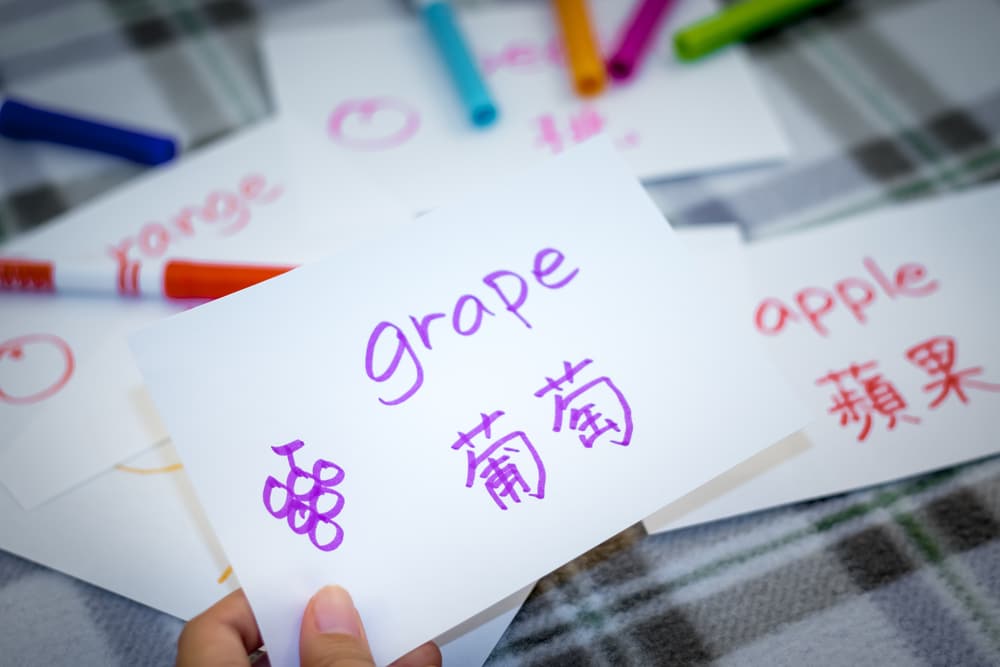
The 12 Hardest Languages to Learn for English Speakers
Learning any language to fluency is a major undertaking, but you’ll find that some languages take more time than others.
If you’re asking yourself “what language should I learn?“, choosing a hard language may just be your answer.
Here are the 12 hardest languages for English speakers to learn, based on the Foreign Services Institute categorization:
Contents
- 1. Arabic
- 2. Mandarin Chinese
- 3. Japanese
- 4. Korean
- 5. Pashto
- 6. Cantonese
- 7. Greek
- 8. Russian
- 9. Turkish
- 10. Farsi
- 11. Hindi
- 12. Polish
- Are Some Languages Really Harder to Learn?
- Why Learn Difficult Languages?
- And One More Thing...
Download: This blog post is available as a convenient and portable PDF that you can take anywhere. Click here to get a copy. (Download)
1. Arabic

Arabic is considered a Category IV language, which is the highest language difficulty. The estimate is you need 2,200 class hours (or 88 weeks) to become proficient in it.
The most obvious way Arabic differs from English is the alphabet. Arabic uses a right-to-left cursive script that draws on 28 letters. Additionally, vowels in written Arabic are often written as small marks above and below words (rather than separate letters!) or even omitted entirely, so readers have to rely on their knowledge of the language to fill in the gaps between consonants.
However, because of the limited number of letters used in the Arabic alphabet, English speakers can develop an intuitive sense of Arabic writing fairly quickly.
Arabic grammar is an involved process, with many surprising inflections and rules. For example:
- Arabic has a singular, plural and dual form, so having two of something is different than having three of something as far as the grammar’s concerned.
- The verb generally comes before the subject in sentences.
- The basic meaning of a word is given by the consonants that form the root of that word, and the precise sense of the word is determined by which vowels are added between the consonants.
- Nouns can be masculine or feminine, and both adjectives and verbs have to match the nouns they’re associated with in terms of gender—unless the noun is an inanimate plural, in which case the corresponding adjectives and verb must be in feminine singular form.
Thanks to these kinds of grammatical quirks in combination with the writing system, learning Arabic can be a mind-bending experience for English speakers. For another perspective on what makes Arabic interesting for English speakers to learn, check out this article from Slate.
And to start learning Arabic yourself, check out these great online resources.
2. Mandarin Chinese

Like Arabic, Chinese uses a writing system unfamiliar for English speakers. Unlike Arabic, Chinese doesn’t have an alphabet. Instead, written Chinese is comprised of one-syllable characters, and every Chinese word is either its own character or a combination of characters. As a result, learning Chinese means internalizing the thousands of different characters that make up the language.
Tones also play a crucial role in Chinese, and words that differ only in terms of intonation can have radically different meanings. Mandarin Chinese has four tones (some varieties of Chinese use more).
That said, Chinese grammar is actually fairly simple for English speakers to pick up. For starters, Chinese’s subject-verb-object word order will feel familiar to English speakers. More importantly, Chinese is pretty much the polar opposite of Arabic as far as inflection goes: Whereas Arabic is highly inflected, Chinese is minimally inflected.
So no need to worry about gender or verb conjugation when learning Chinese. For that matter, no need to worry even about singular vs. plural or tense. These aspects of the language are communicated using word order and context rather than inflection in Chinese.
3. Japanese

The writing system used in Japanese is based on kanji, which are characters adopted from Chinese. Therefore, individual characters tend to be similar in both appearance and meaning from Japanese to Chinese, although some differences have arisen over time.
Beyond kanji, Japanese also uses sets of characters called kana that are used to write grammatical markers, foreign words and other words with no kanji representation. Kana itself breaks down into different classes of characters—so at the end of the day, Japanese writing is an amalgamation of several different scripts.
Japanese writing isn’t the only brain-stretching aspect of the language for native English speakers. Japanese grammar generally takes more time for English speakers to get down because it has less in common with English. For example, the verb goes after the object in Japanese sentences, and Japanese uses postpositions instead of prepositions.
According to some, these features may actually make Japanese the hardest language for native English speakers to learn.
4. Korean

For the last hundred years or so, written Korean has primarily used Hangul, an alphabet consisting of 24 letters. By itself, Hangul is the easiest for English speakers to learn compared to the writing systems in Arabic, Japanese and Chinese.
However, lurking in the background in written Korean is Hanja, the Korean equivalent of Japanese kanji. Hanja, which isn’t based on an alphabet but on borrowed Chinese characters, was the main form of written Korean until the 20th century, and it’s still used in some situations today—for example, to differentiate words with the same hangul spelling.
Korean grammar is similar to Japanese grammar (verb goes after the object, for instance) but a little more complicated. For example, Korean has more particles. Korean also uses more sounds than Japanese, many of them sounds that English speakers aren’t accustomed to.
Both Korean and Japanese are also steeped in complex social etiquette that requires English speakers to adjust their mindset a little. In both languages, there are several different degrees of politeness you can use.
5. Pashto
Another difficult language for native English speakers is Pashto, spoken in Afghanistan and Pakistan.
English speakers find Pashto hard for reasons similar to why they find Arabic hard. First, the Pashto alphabet is related to the Arabic alphabet.
Maybe more significantly, Pashto is a highly inflected language, so learning Pashto means becoming immersed in a world of complex grammatical peculiarities. For instance, which nouns agree with which verbs in Pashto depends on tense.
You might recall that some languages like Japanese tend to use postpositions rather than prepositions. Well, Pashto uses postpositions, prepositions and something called ambipositions—words that fit around nouns like sandwiches.
For a taste of Pashto, check out this website.
6. Cantonese

After Mandarin Chinese, Cantonese is the second-most spoken language in Chinese-speaking regions. It’s primarily used in the southeast areas, such as Guangdong, Macau and Hong Kong.
Cantonese is sometimes labeled as a Chinese dialect, but linguistically it’s argued that it’s its own language: exclusively Mandarin Chinese speakers wouldn’t fully understand exclusively Cantonese speakers (and vice versa). A “chicken talking to a duck” is a common Cantonese saying to refer to this.
Cantonese is considered to have six or nine tones, compared to Mandarin Chinese’s four. This already makes it significantly more difficult for many learners, even for Mandarin Chinese speakers. It’s widely believed that Cantonese pronunciation is regarded as the hardest thing for learners to master.
There’s also a distinction in how written Cantonese is used. While modern-day Mandarin Chinese primarily uses the simplified writing system, Cantonese can be written in two ways: in a specified Cantonese-friendly system (known as jyutping), or in a more standard Chinese system that can be somewhat understood by Mandarin speakers. It’s necessary to learn both, as each one is used in different contexts.
Cantonese grammar is actually quite straightforward. It doesn’t include tenses or conjugations. Like Mandarin Chinese, basic Cantonese sentences follow the Subject-Verb-Object order. However, unlike in Mandarin, Cantonese tends to position adverbs after the verb and indirect objects after the direct objects.
Many agree that Cantonese is overall harder to learn than Mandarin Chinese, especially if one has no prior knowledge of the Chinese language.
7. Greek

The first issue that English speakers will likely have with Greek is its devious alphabet. A few letters certainly look like English ones, but they definitely don’t represent the same phoneme. For example, the German letter H is known as “eta” and can be written as Η/η.
Basic Greek grammar isn’t actually too far off from English’s. It has a similar sentence structure of Subject-Verb-Object, but there isn’t much restriction regarding this order, which can be tricky business. Understanding verbs and their specific functions in sentences can come as a veritable challenge.
Greek verb conjugations can be a big hassle, since there are many notable irregularities to account for.
Greek nouns also come with gendered articles (masculine, feminine or neuter), which are modified based on the sentence case. However, a Greek adjective is also “gendered” based on the noun it modifies.
On the flip side, English speakers can appreciate that they may have a leg up in decoding a good bunch of Greek vocabulary, as plenty of English vocabulary has Greek roots.
8. Russian

The most widely-spoken member of the Slavic language family, Russian comes with its many uses and obstacles for learners.
Russian uses the Cyrillic script for writing purposes. This system was derived from the Greek alphabet (which, as stated earlier, can be head-spinning).
The alphabet consists of 33 letters which are phonetic in nature and, technically speaking, aren’t very difficult to write out. Still, learners can be intimidated by the unfamiliar characters, some of which can look similar to each other.
A unique challenge to Russian consonants is the usage of either a “soft” pronunciation or “hard” pronunciation. These are determined by the vowel following the consonant. Distinguishing between the two can be difficult, particularly in spoken conversation.
Russian grammar is also complex. Russian nouns are designated with one of three “gendered” articles (masculine, feminine or neuter), and there isn’t an exact strategy to figure out which noun has which article.
Sentence structures also don’t follow any standard order–you can shuffle around words in a given Russian sentence and still come upon the same meaning. This aspect may seem convenient, but the caveat is that it also demands knowledge of how the words themselves must be modified to indicate concepts such as tense or case.
The Russian language does so via inflection. Most Russian words can undergo inflection, which means that there is more to learn in regards to conjugation.
9. Turkish

Written Turkish luckily uses the same Latin script as English (with only a few extra letters). Letters are phonetic, so what you read is what you say. There aren’t any gendered articles to worry about either, and there are less pronouns to memorize.
However, several grammatical differences do make the language a bit of a head-scratcher.
Firstly, Turkish sentences typically follow a Subject-Object-Verb order—verbs are always last in a sentence. This is a consistent rule, but it can be a common initial trip-up for English speakers.
Moreover, the language is considered an agglutinative language: words can take on new meanings when given affixes to their roots. The affixes aren’t necessarily arbitrary either, due to another unique concept known as vowel harmony. Vowel harmony dictates that the beginning and end of words must follow certain vowel patterns.
These two concepts in particular make Turkish a unique challenge for English speakers.
While difficult, it’s also agreed that Turkish is overall a systematic and “efficient” language. In other words – there aren’t so many linguistic twists and turns, and once you learn the rules, consistent practice can help take you the rest of the way to fluency.
10. Farsi

Farsi, also known as Persian, is an Indo-European language used primarily in Iran. The rules of Farsi haven’t actually changed much over its long history, but that doesn’t mean they’re readily easy to grasp for modern language learners.
First things first: the Farsi script is certainly very different from the Latin alphabet. Related to the Arabic script, the beautiful but intricate way in which Farsi characters appear demands a critical eye and careful hand. Like Arabic, words are also written from right to left, which can be hard to get accustomed to.
Grammar does have a few advantages. Farsi possesses little to no irregular verbs, genders or adjective inflection. Learners do have to get used to the basic Subject-Object-Verb order, but the process of making sentences in Farsi is a reasonably regular, predictable experience.
It’s also important to note that Farsi is a diglossic language. This means that there are essentially “two versions” in which it’s spoken: a more formal, “by the book” variation, and a more informal colloquial version.
The differences between them aren’t as simple as the contrast between formal and informal English. Learners must learn both Farsi variations, but also know the correct contexts in which to use them.
11. Hindi

Both Hindi and English are the two official languages of India, but for an English speaker, learning Hindi can be a difficult endeavor on nearly every front.
The standard written script, Devanagari, is composed of 46 letters in total. Besides the staggering number of characters and the intricate manner in which they’re written, learners must also recognize that each consonant also automatically comes with a vowel sound. Thankfully, the letters are phonetic, so there aren’t too many confusing enunciation rules.
But the usage of diacritics can make spelling and pronunciation quite nuanced. A single diacritic can completely change the meaning of a word.
Grammar is also, unfortunately, a sophisticated concept. For one, verb (and even adjective) conjugation is gender-specific. Masculine nouns follow a different conjugation pattern to feminine nouns.
All of these obstacles are further heightened by how Hindi is an incredibly diverse language. There are nearly 48 dialects, and they can have variations in vocabulary, pronunciation and even grammar. Learners should be aware of which dialect they’re focusing on.
Again, those with experience in Arabic languages have some advantage when learning Hindi, as the two share some similarities.
12. Polish

Polish, like Russian, is also a Slavic language. However, there are a number of key differences that can come as either a boon or bane for English speakers.
Thankfully, the Polish alphabet is based on Latin script. Besides some diacritically-marked letters and a few stand-out phonemes, the alphabet itself shouldn’t be too hard to grasp. It also helps that a lot of Polish vocabulary has Latin roots, so it’s easy for an English speaker to tell what they mean.
The challenge, however, is Polish has a strong emphasis on consonant sounds–whereas in English, any consonant must be followed by a vowel, Polish can have multiple consonants all together, which complicates both spelling and pronunciation.
The very basics of Polish sentence structure does follow a Subject-Verb-Object order, but similar to Russian, there isn’t much regulation. Words are shuffled around to emphasize certain parts of a sentence–even a verb can be dropped into the very beginning of a sentence. This can complicate the process of forming and decrypting longer sentences.
Polish grammar isn’t a walk in the park either. There are three main genders, but the masculine gender includes subcategories. There’s also a total of seven cases (compared to English’s three).
One saving grace is that there are only three tenses in Polish: present, past and future.
Are Some Languages Really Harder to Learn?
Are some languages actually that much harder to learn, though?
Technically, the answer is no. All languages are evolved to be as easy to learn as possible, and there’s nothing that makes any one language inherently more difficult to learn than another.
However, learning a second language is a little different than learning your first language.
When it comes to learning a foreign language, how hard a language is to learn depends mostly on how different it is from the language or languages you’re already fluent in. Some languages will differ more from your native language in terms of syntax, word order, writing system, vocabulary and so on.
Still, when we say these languages are “harder” to learn, all we really mean is that they take longer to learn. You have to figure out how to memorize more stuff, and you might have to spend more time listening to internalize the flow of the language.
But words are still words and grammar is still grammar. With a good plan and a good language learning method, you’ll still prevail.
Not sure where to start? You can try an immersive language program such as FluentU, which tackles many of these languages–including Mandarin, Japanese, Korean and Russian.
FluentU takes authentic videos—like music videos, movie trailers, news and inspiring talks—and turns them into personalized language learning lessons.
You can try FluentU for free for 2 weeks. Check out the website or download the iOS app or Android app.
P.S. Click here to take advantage of our current sale! (Expires at the end of this month.)

Why Learn Difficult Languages?
Okay, so the downside to learning one of the hardest languages for native English speakers to learn is obvious: You need to set aside more time than if you were learning an “easy” language.
The upsides, though, are a lot more compelling.
To experience an entirely new way of thinking
If you’re learning one of these languages, you’re learning a new, unfamiliar way of thinking. An entirely new writing system, a word order you aren’t used to—whatever.
Research has shown that speaking a language that has little in common with English literally means using your brain in a different way. The very thing that makes some languages especially hard to learn for English speakers also makes these languages especially useful for expanding your perspective and learning a new way of thinking.
To access a very different culture
The less a language has in common with English, the more likely the culture associated with that language is to be very different from the cultures of English-speaking countries.
Learning an especially unfamiliar language is a nice two-for-the-price-of-one deal where you also get to know an especially unfamiliar culture.
To improve your language learning skills
The harder the language you choose to learn, the more it’ll stretch your language learning skills. Learning one of the hardest languages will give your language learning muscles a complete workout, so any languages you choose to learn in the future will seem easier and take you less time to become fluent in.
The one thing shared by these 12 languages that makes them all a handful for native English speakers is that there’s little overlap with English in terms of vocabulary.
Beyond that, though, these languages are all hard for slightly different reasons—writing system, grammar, tones, etc.
Whichever one you choose to learn, you’re bound to discover a linguistic world that is exciting, new and strange in the best possible way.
Download: This blog post is available as a convenient and portable PDF that you can take anywhere. Click here to get a copy. (Download)
And One More Thing...
If you dig the idea of learning on your own time from the comfort of your smart device with real-life authentic language content, you'll love using FluentU.
With FluentU, you'll learn real languages—as they're spoken by native speakers. FluentU has a wide variety of videos as you can see here:
FluentU has interactive captions that let you tap on any word to see an image, definition, audio and useful examples. Now native language content is within reach with interactive transcripts.
Didn't catch something? Go back and listen again. Missed a word? Hover your mouse over the subtitles to instantly view definitions.
You can learn all the vocabulary in any video with FluentU's "learn mode." Swipe left or right to see more examples for the word you’re learning.
And FluentU always keeps track of vocabulary that you’re learning. It gives you extra practice with difficult words—and reminds you when it’s time to review what you’ve learned. You get a truly personalized experience.
Start using the FluentU website on your computer or tablet or, better yet, download the FluentU app from the iTunes or Google Play store. Click here to take advantage of our current sale! (Expires at the end of this month.)





